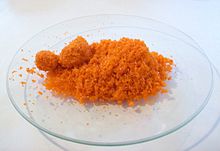Sodium dichromate
| Structural formula | |||||||||||||||||||
|---|---|---|---|---|---|---|---|---|---|---|---|---|---|---|---|---|---|---|---|

|
|||||||||||||||||||
| General | |||||||||||||||||||
| Surname | Sodium dichromate | ||||||||||||||||||
| other names |
|
||||||||||||||||||
| Molecular formula | Na 2 Cr 2 O 7 | ||||||||||||||||||
| Brief description |
Orange-red, odorless, hygroscopic crystal needles |
||||||||||||||||||
| External identifiers / databases | |||||||||||||||||||
|
|||||||||||||||||||
| properties | |||||||||||||||||||
| Molar mass | 261.97 g mol −1 | ||||||||||||||||||
| Physical state |
firmly |
||||||||||||||||||
| density |
2.5 g cm −3 |
||||||||||||||||||
| Melting point |
356.7 ° C |
||||||||||||||||||
| boiling point |
400 ° C (decomposition) |
||||||||||||||||||
| solubility |
very good in water (2355 g l −1 at 20 ° C) |
||||||||||||||||||
| safety instructions | |||||||||||||||||||
|
|||||||||||||||||||
| Authorization procedure under REACH |
of particular concern : carcinogenic, mutagenic, toxic for reproduction ( CMR ); subject to approval |
||||||||||||||||||
| MAK |
Switzerland: 5 μg m −3 (calculated as chromium) |
||||||||||||||||||
| As far as possible and customary, SI units are used. Unless otherwise noted, the data given apply to standard conditions . | |||||||||||||||||||
Sodium dichromate (VI) (Na 2 Cr 2 O 7 ) is a sodium salt of dichromic acid (H 2 Cr 2 O 7 ) and is one of the chromates . It also crystallizes as a dihydrate (Na 2 Cr 2 O 7 · 2 H 2 O, molar mass 297.99 g / mol).
Extraction and presentation
Sodium dichromate is obtained on a large scale from ores containing chromium (III) oxide . The ore is treated with bases (usually sodium carbonate ) at high temperatures in the presence of oxygen:
Reactions in aqueous solution
The aqueous solution has an acidic reaction, since a chromate-dichromate equilibrium is established and hydrogen chromate anions (HCrO 4 - ) are largely formed. The hydrogen chromate anion reacts as an acid :
As OH - ions and H 3 O + ions are always present due to the autoprotolysis of the water , several equilibria are established:
use
It is often used in metal surface treatment (corrosion inhibitor), for impregnation of wood and, among other things, for the production of anti-corrosion pigments, whereby a balance is formed between sodium dichromate and sodium chromate. It is also used in the chemical industry as an oxidizing agent for organic synthesis processes, for example for the synthesis of anthraquinone .
safety instructions
Sodium dichromate is very toxic , oxidizing and dangerous for the environment . It can cause cancer, hereditary problems, affect fertility, and harm the unborn child. Before working with sodium dichromate, the safety data sheet should be consulted and all necessary precautionary measures should be taken.
Individual evidence
- ↑ a b c d e f g h i Entry on sodium dichromate in the GESTIS substance database of the IFA , accessed on February 1, 2016(JavaScript required) .
- ↑ Entry on Sodium dichromate in the Classification and Labeling Inventory of the European Chemicals Agency (ECHA), accessed on February 1, 2016. Manufacturers or distributors can expand the harmonized classification and labeling .
- ↑ Entry in the SVHC list of the European Chemicals Agency , accessed on July 14, 2014.
- ↑ Entry in the register of substances subject to authorization of the European Chemicals Agency , accessed on July 14, 2014.
- ↑ Swiss Accident Insurance Fund (Suva): Limit values - current MAK and BAT values (search for chromium (VI) compounds ), accessed on October 7, 2019.
- ↑ Patent DE 2707486C2
- ↑ Script Uni Mainz











